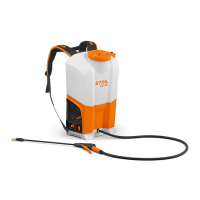0458-600-8221-A
12
English
5 IMPORTANT SAFETY INSTRUCTIONS
■ To reduce the risk of serious or fatal injuries to the
operator or bystanders from loss of control, keep proper
footing and balance at all times:
– Take special care in overgrown or wet terrain and
always watch for hidden obstacles such as tree
stumps, roots, rocks, holes and ditches to avoid
stumbling or falling.
– Be extremely cautious when working on slopes or
uneven ground.
■ To reduce the risk of injury from loss of control:
– Never work on a ladder, roof, in a tree or while
standing on any other insecure support.
– Do not overreach. Keep proper footing and balance
at all times.
■ To reduce the risk of injury from loss of control:
– Stand upright while working and avoid bending at the
waist.
5.7.4 Working Conditions
WARNING
■ Operate your sprayer only under good visibility during
favorable daylight conditions.
– Postpone the work if the weather is windy, foggy,
rainy or inclement.
■ Your sprayer is a one-person machine.
– Do not allow other persons in the general work area.
– Bystanders, especially children, and animals should
not be allowed in the area where it is in use.
– Switch off the sprayer immediately if you are
approached.
■ To reduce the risk of injury to bystanders and
unauthorized users:
– Never leave the sprayer unattended when the
battery is inserted.
– Switch off the sprayer and remove the battery during
work breaks and any other time the sprayer is not in
use.
■ Sparks generated from the operation of the sprayer may
be capable of igniting combustible gases, liquids, vapors,
dusts or other combustible materials and substances. To
reduce the risk of fire and explosion:
– Never spray combustible liquids or operate the
sprayer where combustible, vapors, dusts or other
combustible materials and substances are present.
– Read and follow recommendations issued by
government authorities (e.g., CCOHS) for identifying
and avoiding the hazards of combustible gases,
liquids, vapors, dusts or other combustible materials
and substances.
■ Inhalation of certain chemicals may cause respiratory
disease, cancer, birth defects, or other reproductive harm.
– Control chemical spray at the source where
possible.
– Use good work practices. Operate the unit so that
any wind or operating process does not blow the
spray back on the operator.
– Follow the recommendations of ECCC, CCOHS and
PHC and occupational and trade associations with
respect to proper usage.
– The operator and any bystanders may need to wear
a respirator approved by PHAC/MSHA for the type of
chemical encountered. Consult the label of the
chemical product being used.
– If you are unfamiliar with the risks associated with
the particular chemical at issue, review the product
label and/or material safety data sheet for that
substance and/or consult the material
manufacturer/supplier. You may also consult your
employer, governmental agencies such as the
ECCC, CCOHS and PHAC and other sources on
hazardous materials. The state of California and
some other authorities, for instance, have published
lists of substances known to cause cancer,
reproductive toxicity, etc.

